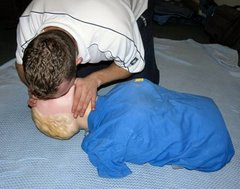Cardio Pulmonary Resuscitation (CPR)
NOTE: This information should be read in close conjuction with the Rescue Breathing and Chest Compression lessons.
Cardio Pulmonary Resuscitation (CPR):
If the casualty is not breathing by themself you must breathe for them - this is achieved by giving Rescue Breaths. If the casualty has no signs of life it is an indication that blood circulation is absent. As a first aider you must provide the casualty with circulation - this is achieved by giving Chest Compressions. The combination of Rescue Breaths and Chest Compressions is known as Cardio Pulmonary Resuscitation (CPR).
Sequence of CPR:
- In the case of a casualty needing CPR, the primary survey will be as follows:
- DANGER - Remove all danger from yourself and the casualty.
- RESPONSE - The casualty is unresponsive - shout for help.
- AIRWAY - Ensure the casualty's airway is clear and maintained.
- BREATHING - The casualty is not breathing.
- As soon as you see the casualty is not breathing go for help if it is not already on the way (if you suspect the casualty is not breathing due to injury, choking or drowning give 5 rescue breaths followed by 30 chest compressions before going for help).
- After going for help give the casualty 30 chest compressions.
- Give the casualty 2 rescue breaths.
- Continue giving cycles of 30 chest compressions to 2 rescue breaths until either help arrives, or the casualty begins to breathe spontaneously or you become too exhausted to continue.



